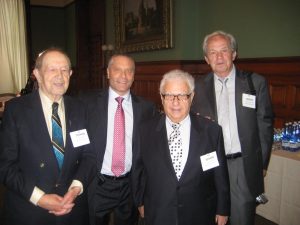In July 1944, as the SS liquidated the Kovno (Kaunas) Ghetto in central Lithuania, 16-year old Elly Gotz hid with his mother, Sonja, a surgical nurse, his father, Julius, a bookkeeper, and several other family members in the corner of a basement.
His mother had prepared injections of potassium chloride and was prepared to kill her son, herself, and everyone else rather than be murdered like thousands of Kovno’s Jews. The Gotz family avoided detection for three days, until Nazi soldiers entered the building where they were hiding, peered down into the dark basement, and ordered them out.
But fate intervened that day, and Elly and his family stayed alive.
The story of how that fateful moment came about, and the tragic events that preceded and followed it, are told in Elly Gotz’s poignant and remarkable Flights of Spirit (published by the Azrieli Foundation’s Holocaust Survivor Memoirs Program and Second Story Press). The foundation is to be commended for its support of this significant program, especially given the ever-dwindling number of survivors still able to relate the stories of their lives.
Gotz was born in March 1928 in Kovno and came to Toronto in 1964 via Norway and Rhodesia (today, Zimbabwe). His wartime story stands out not only because he was a teenager when the Nazis marched into Soviet-controlled Kovno in July 1941, but more significantly because his survival owed much to the skills he acquired in the ghetto as a locksmith and metal worker.
In the larger perspective, Gotz, though he did not know it at the time, was an unwitting participant in the Nazi conflict between the “productionists” – those Nazi leaders who saw some value in using (and feeding) slave labour – and the “attritionists,” who were prepared to let the Jews work, starve and die — what has been aptly labelled “destruction through labour.”
Ultimately, the “attritionists” won this morbid debate, but did not completely achieve their objective. Jews relegated to slave labour, and in particular Jews, like Gotz, who had skills the Nazis valued, managed against the odds to survive.
Gotz’s designation as a “valuable Jew” by no means meant he was treated humanely, but as his memoir makes clear, his intelligence, resourcefulness and courage — along with a dose of teenage guile — kept him alive. In the summer of 1942, about a year after approximately the 30,000 Jews of Kovno had been forcibly segregated in a ghetto — the population numbers were soon reduced through deportations and mass slaughters in “actions” periodically carried out by the Nazis — Dr. Elchanan Elkes, the creative and compassionate head of the Kovno Jewish Council of Elders, the Aeltestenrat (also referred to as Judenrat) obtained Nazi consent to set up a ghetto vocational school for youngsters aged 12 to 15 years of age. Gotz, who liked mathematics and science as a student, was a prime candidate and he learned the intricacies of becoming a locksmith.
READ: ‘FABLED CITY’ IS A WELCOME ADDITION TO CANADIAN JEWISH HISTORY
One day, there was an exhibition of the workshops’ achievements inspected by Nazi officers. “I was proud that one officer pointed to my shiny, handmade padlock, but then very unhappy when he said he wanted it and took it away,” writes Gotz. “To add insult to injury, I had to make him a second key!” However, he adds, “as I look back, I must give credit to those dedicated and inspired teachers. Life in the ghetto was miserable, and the school was a place of respite.”
Later, he and his father were transported to a sub-camp of Dachau (and were separated from his mother), where Gotz smartly declared that he was a mechanic. He was assigned to a machine shop and immediately performed well enough for the Nazi “Meister” (master) to sneak him more food.
On April 29, 1945, Gotz and his father, who was by then close to death, were liberated from the main camp at Dachau by American soldiers. Miraculously, they soon discovered that Gotz’s mother had also survived as had her brothers and other family members. Desperately wanting to get out of Germany, they found refuge first briefly in Norway and then in Rhodesia where Gotz’s uncle, Samuel Gotz lived. They remained in Africa from late 1947 until they immigrated to Toronto.
During the late 1940s, the Jews Gotz met in Rhodesia, like Jews in Canada and the United States, had little interest in hearing the harrowing stories of the war. He did not talk about what he had endured for 25 years. But in Toronto, he was actively involved in what is now the Sarah and Chaim Neuberger Holocaust Education Centre, and has delivered hundreds of presentations about his experiences to students.
A letter he wrote from Germany to his uncle and aunt in Rhodesia in October 1945, when he was 17 years old, captures the spirit that runs through his memoir: “I really do not know where to start my letter, after an interruption of almost five years. There is so much to tell and so little space! … One needed so much luck, mazel. The life of each one of us hung on a hair; death was not in our hands but in front of our eyes, so one must become a fatalist and believe in blind luck.”






